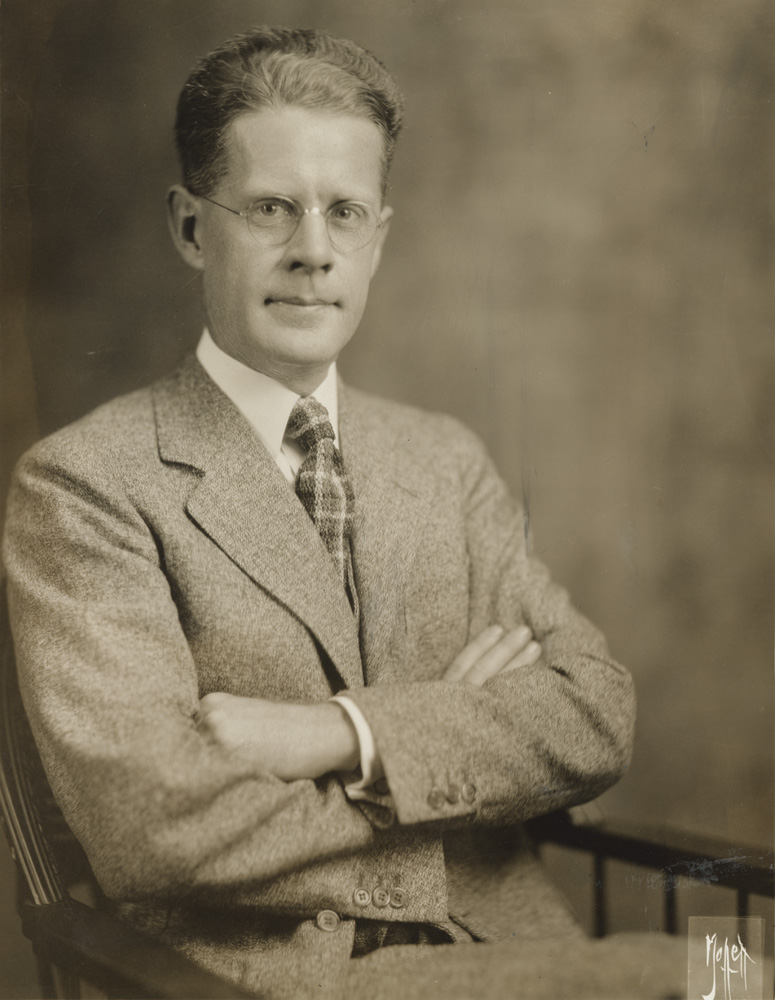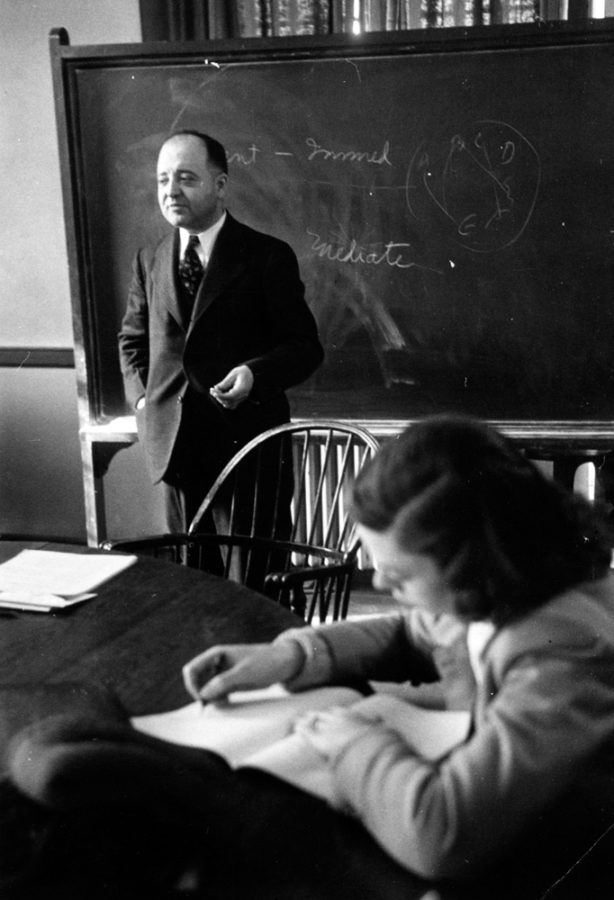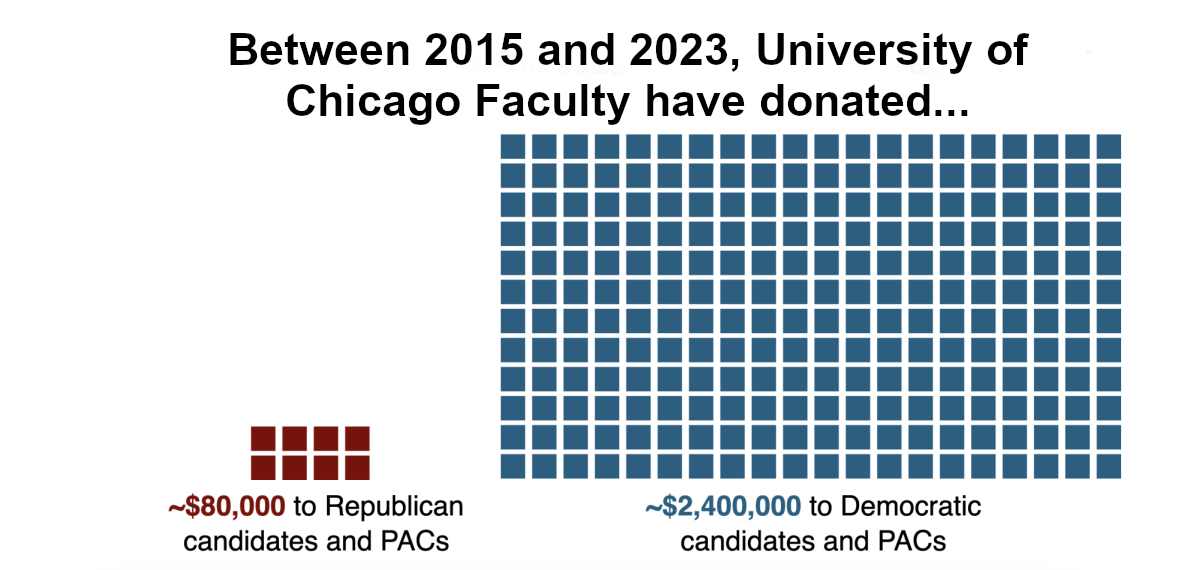It’s your first day of classes at UChicago. You’re still recovering from the information overload of O-Week, and end up winding through the quad as you try to find Cobb Hall. You stumble upon the building and make it to the third floor with just two minutes to spare until Readings in World Literature starts. The professor hasn’t arrived yet; you look around and find an open seat at the other side of the room, in between two unfamiliar students. All the tables are arranged to make a rectangle, so everyone in the class can see everyone at once. It’ll be tough for you to zone out in this Panopticon—but you don’t know that word yet. You scuttle over to the open seat and sit down, hoping you weren’t supposed to read something before class.
Every student of the college at the University of Chicago takes at least two humanities (Hum) and three social science (Sosc) core classes as a backbone to every student’s time at the University.
The discussion-centered, analysis-heavy Hum and Sosc Core classes cover a diverse range of material, and each has its own focus within their fields. Power, Identity, and Resistance, for instance, covers a different swath of the social sciences than Classics of Social and Political Thought; Media Aesthetics and Readings in World Literature are both humanities classes but speak to different types of media. Yet the pioneers of the humanities and social science Cores created the original courses in 1931 with more specific aims in mind.
What were those original aims, and how do some of today’s Hum and Sosc Core classes speak to them?
The Maroon looked into the early history of the Core and spoke with four then-Core chair professors in order to figure out how those aims speak to the Core today. (Core chairs are professors who guide the curricula of a specific Core class for the quarter.)
“Distinctly Something More”: How the Core Began
The early aims of the Hum and Sosc Cores are connected to their founding.
According to College Dean John Boyer’s The University of Chicago: A History,in the late 1920s, student enrollment at the University of Chicago’s undergraduate colleges had grown so large that more graduate and temporary teachers had to step in to teach classes. (Before President Robert Maynard Hutchins reorganized the entire University in the 1930s, UChicago’s undergraduates were grouped into three different colleges.) Graduate and temporary teachers taught 94 out of the 124 sections for some 34 courses. Students complained about the quality of their education; less academically qualified students were admitted, and there were even rumors that the University was thinking of shutting down the undergraduate schools entirely.
At the time, each academic department chose how to structure its own classes. “The Dean of the Colleges never knows what is to be our program for any quarter until the time schedule is in print,” Dean of the Colleges Chauncey Boucher wrote in 1928. Without a framework for each department to follow, classes were inconsistent in quality, and there was no coherent path of study for undergraduates.
Boucher’s proposed solutions to these issues, which he developed over the rest of the decade, included attracting more academically talented students to UChicago’s College and forming a more coherent, structured curriculum beyond the jurisdiction of individual departments.
On May 7, 1928, Boucher presented a wide-reaching reform plan to the University Senate that called for, among other reforms, a junior college, “general education competency exams” to monitor students’ progress, new specialized courses, and most importantly, “the revision of the curriculum for the first two years of the undergraduate work centered on the development of broad survey courses in place of ad hoc departmental offerings,” as Boyer puts it.
In other words, he called for a coherent course of study for undergraduates, using survey courses that would give students a broad overview of the topics at hand.
In 1929, Hutchins became president of the University, and Boucher convinced him to back the proposed new curriculum along with other administrative reforms Hutchins was helming. One of these was the separation of the University into distinct graduate divisions and an undergraduate College.
In December 1930, Boucher led a committee that created a brand-new College curriculum, with four “general survey courses” as its centerpiece. According to Boyer’s monograph, A Twentieth-Century Cosmos: The New Plan and the Origins of General Education at Chicago, “Boucher adapted and expanded the structural idea of an interdisciplinary, trans-departmental ‘survey course’ for freshmen” that began in 1934. The courses would not be graded but would have “six-hour final comprehensive exams administered by an independent Office of the Examiner…. Students could pace themselves through the curriculum, taking the final comprehensives whenever they felt prepared to do so.”
The survey courses were referred to as “Introductory General Courses,” and Boucher later wrote in his 1935 book The Chicago College Planthat the name was intentional.

“Our new courses were to be a further development of the basic idea of the survey course, but were to be distinctly something more: they were to be broader in scope…less superficial than the survey courses of the then prevailing type,” he wrote.
According to A Twentieth-Century Cosmos, Boucher convinced the prolific and recently retired European civilization historian Ferdinand Schevill to return to UChicago in order to create the new humanities survey course alongside Arthur Scott, professor of history, and Hayward Keniston, professor of Spanish and comparative linguistics.
As for the social sciences, three professors came together to form that subject’s new survey course: economist Harry Gideonse, political scientist Jerome Kerwin, and trailblazing urban sociologist Louis Wirth.
“The intellectual, emotional, and artistic values in life”: The Aims of Humanities, Then and Now
In their “Preliminary Report of the Committee in Charge of the General Course in the Humanities,” Schevill, Scott, and Keniston stated that the goal of their humanities course was to introduce undergraduates to “the cultural history of mankind as a continuum and as a whole.” This cultural history encompassed both arts and ideas, mainly from European thinkers; students read classics such as the Odysseyand works by Shakespeare, Voltaire, Darwin, and many others as part of the survey course.
In the “Preliminary Report,” the trio discussed the humanities survey course’s aim of using “history as a foundation and framework for the presentation of the religion, philosophy, literature and art of the civilizations which have contributed most conspicuously to the shaping of the contemporary outlook on life.”
In an interview with The Maroon, Samantha Fenno, lecturer in the Humanities Division and Core chair of Hum Core sequence Human Being and Citizen (HBC), weighed in on Schevill’s claim about the humanities as cultural history.
“My understanding of the origins of HBC was that it really was trying to do a cultural history of mankind as a continuum, so it started with [the biblical book of] Genesis and led up to the present moment,” she said.
HBC was created in 1977 by professors Amy and Leon Kass; according to Fenno, many of the texts in HBC and in humanities courses in general are meant to remain constant throughout the years, though there is some leeway to addition and subtraction in the syllabus.
In today’s HBC, “history is[still] important…Aristotle and Dante and Homer engage with the human condition in ways that still speak to us,” Fenno said. But unlike the chief emphasis that the Hum Core and HBC once had on history, “the way that we engage with the text…has a more critical dimension to it [nowadays].”
In response to Schevill’s aim of the humanities to expose undergraduates to “the cultural history of mankind as a continuum and as a whole,” Classics professor Sarah Nooter, who developed Poetry and the Human (PATH), the newest Hum Core class, said that aim is clearly very historically determined. “There is a lot of history in PATH,” she said, “but [the course] also aims very purposefully to not suggest that it’s offering some sort of ‘cultural evolution.’”
Another critical glimpse into the original aims of the humanities and social sciences at UChicago comes from the syllabi for the subjects’ first survey courses—full books with many of the required readings included inside, along with lists of books to read for the course. (Old University syllabi can be found in the Regenstein Library bookstacks.)
The preface of the Introductory General Course in the Humanitiessyllabus proclaims that “our particular course in the humanities deals primarily with the intellectual, emotional, and artistic values in life. For the most part we limit ourselves to the background of our own Western type of civilization, without denying the interest and importance of other (notably the Asiatic) types.”
In more recent decades, Hum courses have expanded beyond the Western canon, yet face challenges in balancing the drive for inclusion with the desire to retain the established works.
“I think there is an attempt to be more inclusive, that is, to work outside of the canon,” Nooter said when asked about the recent evolution of humanities at UChicago and attempts to bring in new authors. “It’s tricky, because these [works already included] are great works, and it’s hard to do the subtraction work, hard to add in new work.”
In her talk with The Maroon, Fenno emphasized the collaborative and constructive aspects of studying the humanities in addition to its inclusion from historical canons.
“Humanities is at its core an activity,” she said. “When we’re asking what makes a good human being or citizen, and what’s the difference, we’re doing the humanities; we’re not just looking at something that somebody in the past wrote, and only trying to understand what they’re saying.”
She recognizes that this is one of many different perspectives on the humanities. “An older, ‘great books’ [perspective] might be that we read these old texts because they have something to teach us, and our primary inquisition is a respective one towards the text,” she said.
But in recent years, Fenno’s seen the study of humanities focus more on “the way we understand what it is that we’re doing, what we should highlight from the texts and traditions we’re entering.”
“Contrast the social order…with contemporary society”: Studying the Social Sciences, Past and Present
In the first edition of the syllabus for the Introductory General Course in the Social Sciencessyllabus, edited by Gidonse, Kerwin, and Wirth, the preface sets forth a specific set of aims for the course: “We propose to study economic, political, and social institutions in the perspective of the industrial revolution. We shall contrast the social order that preceded the industrial revolution with contemporary society and trace the processes of transformation by which these changes were brought about, with a view to providing a suitable background for the understanding of the major social problems of the present day.”
The chapters that divide the syllabus reflect this, from “the development of the present economic order,” “the industrial revolution and social change,” and “modern industrial society.” The course also addressed government’s role in society via topics such as “the administration of the modern governmental structure” and “popular control of governmental functions.” The course’s reading list included many American works not contained within the syllabus book, such as Herbert Hoover’s American Individualism (1922) and Norman Thomas’s America’s Way Out (1931).
Nathan Tarcov, who was the autumn 2017 Core chair for Classics of Social and Political Thought, told The Maroonduring an interviewthat he thinks that sort of industrial revolution-based lens appears more in the third quarter of Classics , which includes readings by Karl Marx and other post-industrial revolution thinkers.
Akin to many older University courses, the original social sciences course was mostly focused on Western civilization and a Eurocentric view of the world, even while including American works “in a bow to Schevill’s notion that America was also a part of Western civilization,” as Boyer puts it in A Twentieth-Century Cosmos. The course insisted, according to Boyer, that “European civilization itself bore within it the fate of modern man, and that in studying this fate, American university students would come to appreciate and analyze their own situations more acutely and self-consciously.”
Nowadays, Sosc professors have made efforts to broaden the syllabi to more diverse voices.
Tarcov told The Maroonthat his section of Classics also includes writings by ninth-century scholar Al-Farabi, who lived in Baghdad and Damascus. “I think that it’s important to include political philosophy in the Islamic world in that survey…. In the ninth to 10th century, the tradition of Western political philosophy was much more alive in Baghdad and Damascus than it was in Europe,” he said.
But Tarcov also spoke to the philosophy behind classical and early modern thinkers. “They are, in a way, the founders of a tradition of Western political thought. They set up many of the issues and challenges that later thinkers address,” he said. “I’d also say that really so far as people—postmoderns or something else—try to have a critical stance on modernity. I think it’s very helpful to have a sense of premodern thought, of what it was that people like Machiavelli, Hobbes, Locke, were breaking with, were arguing against. For that purpose, reading [thinkers] like Plato, Aristotle, Thomas Aquinas, is indispensable.”
In his talk with The Maroon, Gary Herigel, political science professor and Core chair of the Sosc sequence Power, Identity, and Resistance, addressed the interaction between Western and non-Western works, and why both have a place in Power,which seeks to expose students to a number of interpretations on a few basic relationships between an individual and a state.
“There’s a kind of historical significance to some of the primary works that deal with power, that are associated with the emergence of the West. Those works articulate very specific cultural and geographic and historical conceptions of what the political should be, and what liberty is, what’s rational and what’s not,” Herrigel said. “We expose students to those ideas and then we spend the winter and the spring reading criticisms of those basic ideas…. We also read works from the non-West, alternative conceptions of the political, and what’s just, and what’s right, what’s rational.”
The original survey course emphasized the development of critical thinking among students. In correspondence between Scott and Boucher, Scott wrote that the course would not only teach about European culture and showcase its “practical value to young people presently to be adult members of twentieth century American society,” but would also foster “straight and independent habits of thinking, as by-products of which it may fondly be hoped that a more critical, rational, tolerant, and broad-minded attitude may be fostered.”
Boyer’s A Twentieth-Century Cosmossays that this manifested itself in a course that was “replete with facts and dates, but also had a more ambitious agenda in that it hoped to encourage analytic study skills and intellectual self-confidence among its students.”
Herrigel echoed these themes when discussing the modern Power course and the tension between telling students distinct principles or letting them work them out for themselves. “We just do the latter,” he said. “The whole point is that there are, out there in the world, very deeply held normative values…. We need to be able to negotiate those, and to sort of live in a world in which being able to dispassionately and with reason deliberate about particular problems from different points of view.”
Former Deputy News Editor Feng Ye contributed reporting.
Editor’s note: The Core chairs quoted in this article were interviewed in autumn 2017 as research for a piece that was not published.









